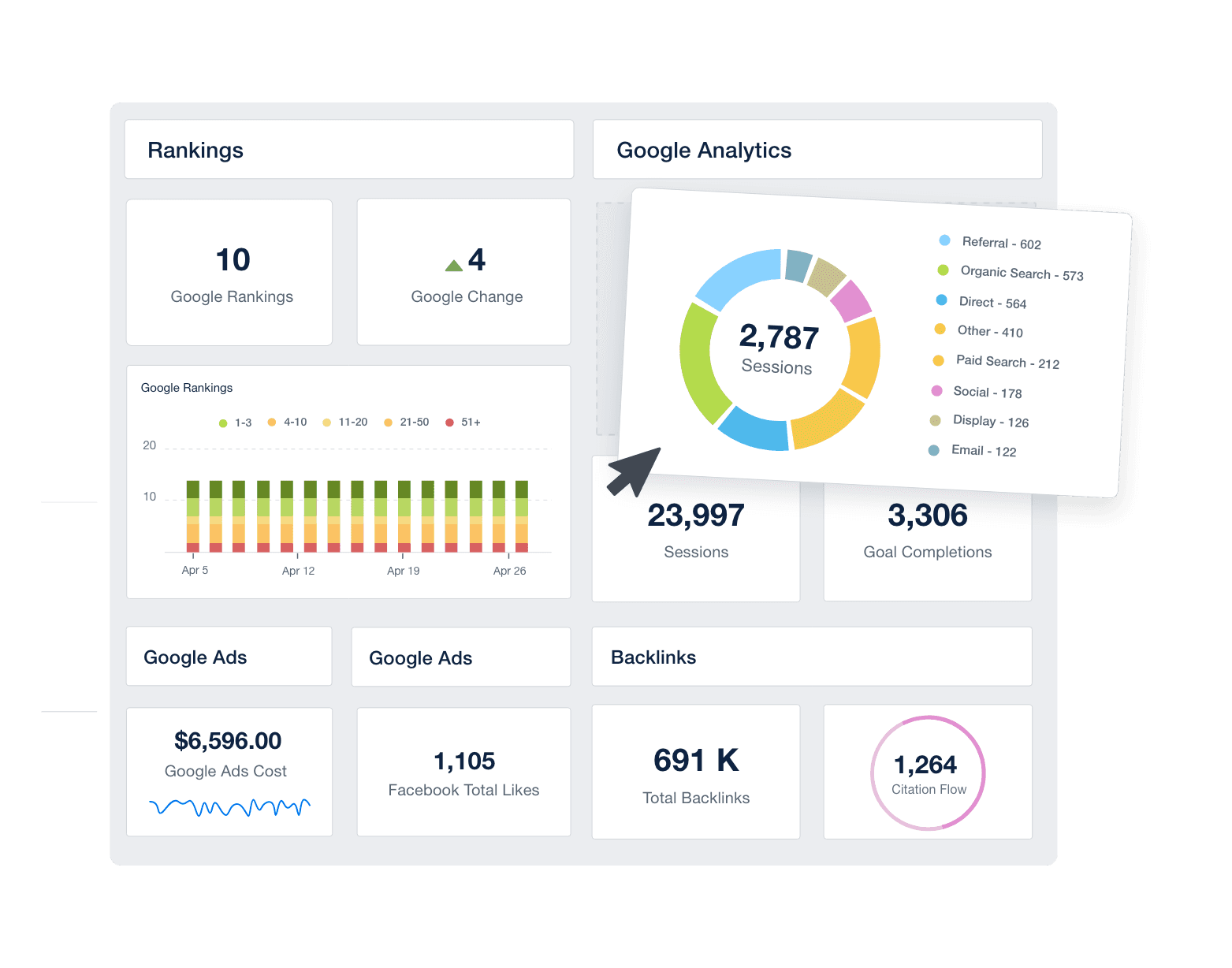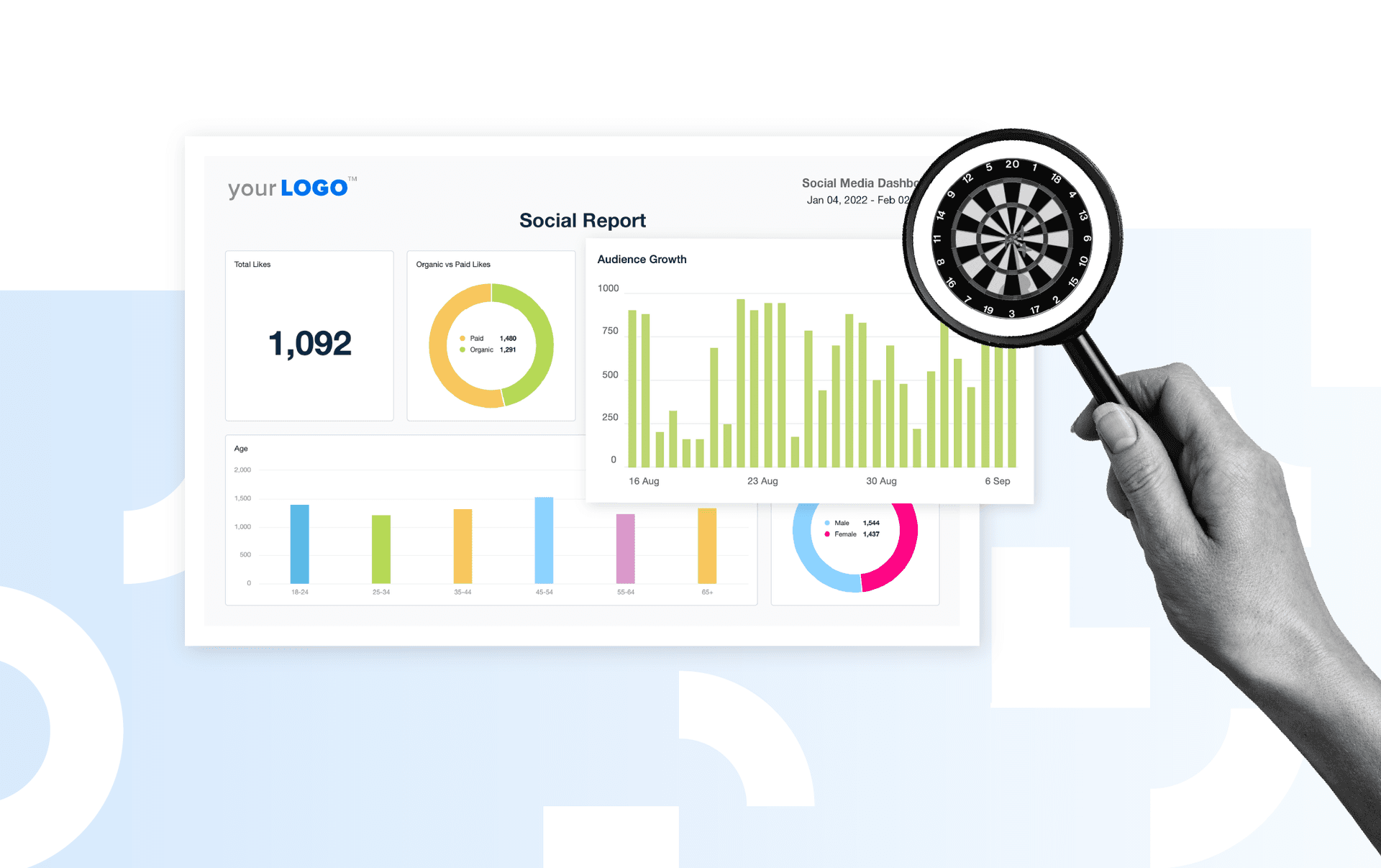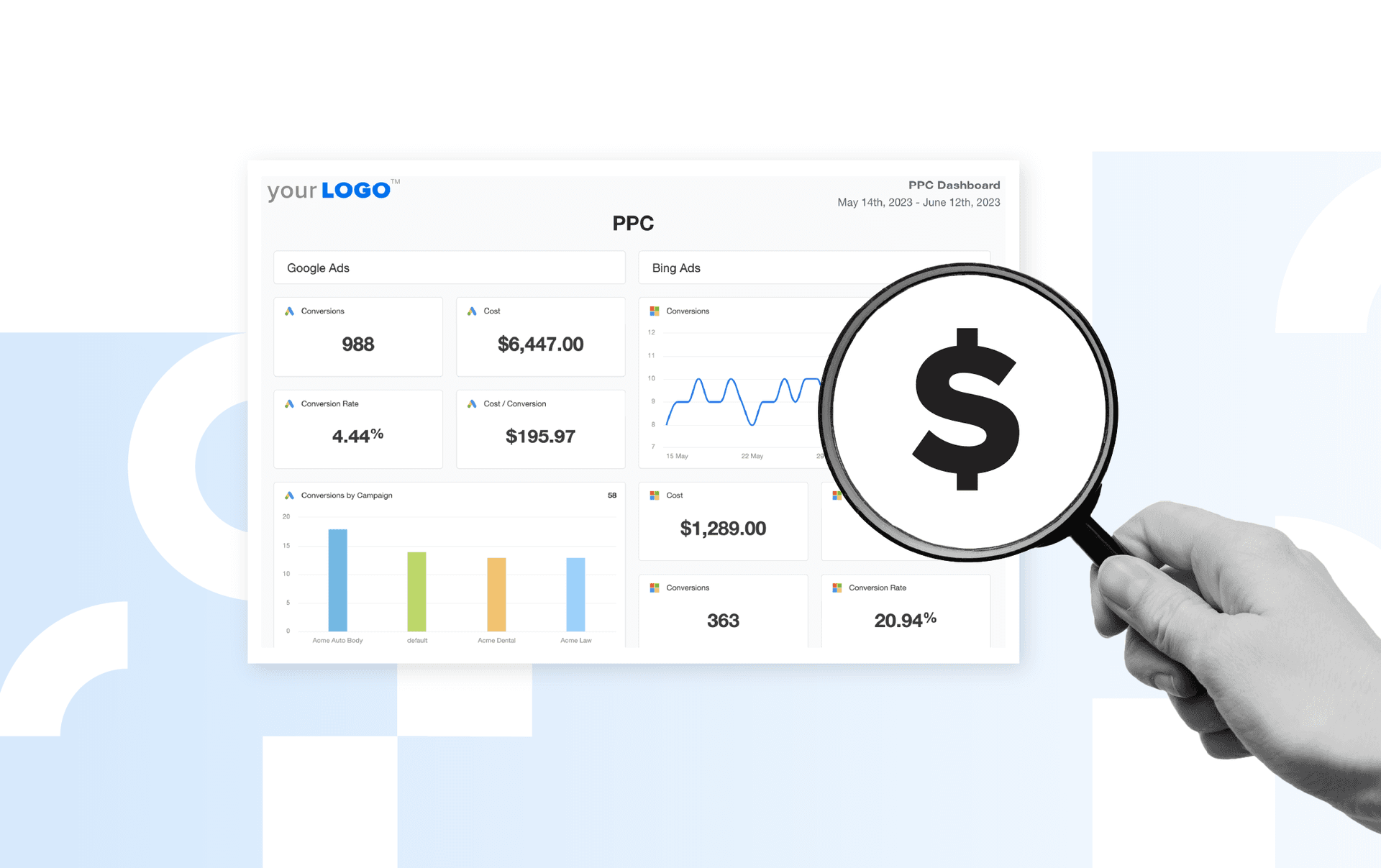Table of Contents
Table of Contents
- What Are Vanity Metrics?
- Why Vanity Metrics Are Problematic
- How To Identify Vanity Metrics
- Vanity Metric Examples from Top Marketing Agencies
- When To Use Vanity Metrics
- The Difference Between Vanity Metrics and Actionable Metrics
- Actionable Metrics That Your Agency Should Use
- Report On The Actionable Metrics That Matter Most
7,000+ agencies have ditched manual reports. You can too.
Free 14-Day TrialQUICK SUMMARY:
Vanity metrics are data points that superficially indicate campaign performance but fail to align with crucial business goals, KPIs, or revenue. They can skew marketing perception and set unrealistic expectations. This post delves into distinguishing vanity metrics from valuable insights, offering guidance on discerning what's essential for reporting.
Repeat after us–vanity metrics and no tangible results make marketing a wasted effort.
Metrics are everything when it comes to data-driven marketing. But what happens when they’re misleading, exaggerated, and produce numerical fluff? Inflated expectations and client disappointment–that’s what. And this is why your agency must distinguish vanity metrics from actionable metrics.
We’re sure you’ve been in a situation where a client continuously checked the number of views on a beautifully-created social media post and was so stoked to see high visibility–only to realize later that it resulted in next to no conversions. Your agency was then asked, “Why didn’t I get any sales from this post? There were literally thousands of likes on it!”
You then explained that likes are nice, but they don’t always count as actionable metrics or account for other key factors (such as their target audience's perception). So the million-dollar question remains–how does your agency differentiate a vanity metric, which just looks good on paper, from the ones that produce valuable, actionable insights?
Before you hit ‘Send’ on a client report with a ton of sugarcoated vanity metrics, read this article.
What Are Vanity Metrics?
Vanity metrics are those stats that you like to show off to make the efforts you're making look good for you, but in the end, really don't mean anything–especially towards the end business goals you really want to achieve.
Nathan Hawkes, President of Arcane Marketing
Simply put, vanity metrics are any data points that give some indication of campaign performance on a surface-level basis but don’t contribute to your client’s business goals, KPIs, or revenue.
Not only does a vanity metric have the potential to inflate an overall marketing picture, but it also opens the floodgates for unmet or even unrealistic client expectations. Reporting on or failing to contextualize vanity metrics leads to questions, doubts, and confusion–especially when clients aren’t as deeply immersed in the marketing waters as you.
Why Vanity Metrics Are Problematic
Relying on surface-level vanity metrics has profound implications. It may even lead to cringe-worthy situations that you and your clients want to avoid.
Take a fitness client trying to increase enrollment and build a buzz for a new, upcoming spin class. For a week, your team boosts a social media post and even hands out flyers to interested people on the street. Your client is beaming with excitement because their video views are racking up, and over 500 flyers were distributed. As far as they can tell, it’s on track to be a packed event.
Thursday’s highly-anticipated 8 PM class finally rolled around, and much to your client's surprise, only two people showed up. To add salt to the wound, your client went through the drama of booking a larger space and even hired a live DJ for the initial class launch.
It’s not a stretch to decipher what happened:
Distributed flyers and video views did not mean that conversion was promised (in this case, in-person class attendance).
Outreach efforts did not indicate how their target audience perceived the messaging.
These metrics held no insight into the existing marketing landscape (such as a competitor’s class scheduled on the same day and time).
When considered in isolation, vanity metrics promise the world and paint a picture of favorable campaign results if you or your client aren’t careful.
Any metric taken in isolation is a vanity metric. To understand performance, you need a range of KPIs, and they need to be analyzed together. Traffic is no good unless you understand what keywords are driving that traffic and whether they're generating conversions or sales.
Paul Morris, Managing Director of Superb Digital
How To Identify Vanity Metrics
Vanity metrics may be difficult to identify, especially since they’re part of robust platforms such as Facebook Ads and Google Analytics. They’re easily accessible at first glance, making them even more appealing to report on when you’ve got a million other things to do. Don’t get swept away by the vanity metric wave, though!
Even well-formatted analytics from reputable platforms come with limitations. And there’s a bit more analysis you should conduct before deciding what to present to your clients.
Which KPIs are Most Likely To Be Vanity Metrics?
A KPI most likely to be considered a vanity metric is one that appears impressive but doesn't meaningfully contribute to achieving core business objectives. Examples include page views, likes, followers, or any other metric that emphasizes quantity over quality. These metrics may look good on reports but often fail to provide actionable insights or a direct correlation to business growth, revenue generation, or customer engagement.
Ready to weed out those vanity metrics for good? Here are a few questions to consider:
Does this marketing metric contribute directly to my client’s strategic business goals, revenue, and/or KPIs?
If there was a change in this metric, would it affect my client’s bottom line?
Is it in my client’s best interest to make strategic decisions based on this metric?
If taken in isolation, does this metric accurately depict any significant part of what’s happening in my client’s overall business objectives?
Is there a more relevant version of this metric that provides better insights (e.g. total users versus active users)?
If you answer ‘no’ for most of these questions, it’s a sign to put that vanity metric on the back burner.
Agency Tip: Differentiate your agency from competitors by taking the extra time to outline what’s a vanity metric and why it isn’t the best measure of success for any given client campaign. Sharing these upfront insights sets the stage for what your client should expect from their marketing efforts and shows your agency’s dedication to effective communication.
Vanity Metric Examples from Top Marketing Agencies
Who’s better to ask about vanity metrics than a marketing agency? Here are some real-life scenarios that top agencies have navigated through. After all, you live and you learn!
Social Media Follower Count
The number of followers on social media can be deceptive. It may look nice, and perhaps that's why some companies fall prey to false promises and buy followers. However, this vanity metric lacks depth, providing little substance and minimal insight into a brand's actual influence or engagement. There are several social media metrics that fall into the vanity category, so be sure to focus on meaningful social metrics—such as engagement rate, conversion rate, or click-through rate—paint a clearer picture of genuine audience interaction.
Vanity metrics include data such as followers, page views from Google Analytics, subscribers, and other flashy analytics that are satisfying on paper. Reporting on page likes made one client very happy, and the significant growth of these numbers looked very good. However, only 1% of those converted and ended up only growing engagement but pushing no revenue.
Bounce Rate
Bounce rate, defined as the percentage of visitors who leave after viewing a single landing page, can be a misleading gauge of user interest. Although it might seem like a low bounce rate indicates success, it doesn't provide context on how much time spent was truly valuable or how many people are taking action on the page. A more accurate measure of user engagement is not just the quantity of page views, but the quality of interaction they reflect.
Overall website bounce rate is probably the biggest vanity metric. Clients can get fixated on it rather than looking at it on a page-by-page basis. This could lead you to spend time on tasks that aren't helping the campaign's primary goal.
Paul Morris, Managing Director of Superb Digital
Cost Per View or Impression
Cost per view or impression might seem like a straightforward metric for a marketing team, but it's often overly simplistic. Yes, it reflects the cost of reaching each potential customer, but it doesn't account for whether those viewers actually engage with the content. Metrics like click-through rates or cost per click provide a more complete picture, showing not just how many saw the content, but also how many found it interesting enough to take action.
One time, on an online ads campaign, we were bragging about how well the campaign seemed to be going because of our cost per view, which was $.004. However, in the end, we didn't get the revenue needed to prove success. It got the client excited for the moment, but in the end, it was not a success. The client saw the end results of the campaign, and it was not impressive.
Nathan Hawkes, President of Arcane Marketing
Keyword Rankings (Without Context)
Scoring high keyword rankings may feel like a winning scorecard, but in the game of vanity metrics vs. valuable insights, they don't hold the trophy. These rankings don't offer the bigger picture in any kind of meaningful way. To make sense of this data, you need a better understanding of how many new customers were gained, how much relevant traffic was generated, or how much total sales increased due to the high-ranking keyword.
Probably the most common theme of what has upset clients in the past is reporting on positive-looking metrics that seem to indicate we're making good progress, e.g., rapid ranking increases of keywords with zero search volume when from the client's point of view, they're getting zero return on investment because those increases aren't driving the results they wanted to see.
Daniel Noakes, Founder of UClimb
Here are some other common vanity metrics that do not always provide actionable insights or help inform a critical business decision (especially when considered out of context):
SEO Vanity Metrics | PPC Vanity Metrics | Social Media Vanity Metrics | Email Marketing Vanity Metrics |
|---|---|---|---|
Pageviews | Impressions | Post Reach | Number of Subscribers |
Indexed Pages | Likes | ||
Total Links | Spam Complaint Rate | ||
Organic Traffic | New Leads | Story Views | Forward Rate |
Crawl Errors | Page Views | Unsubscribe Rate |
Want to provide crystal a clear report that informs future strategies? Create custom marketing dashboards with metrics that tie into your clients' business objectives. Track actionable insights and show your clients tangible results–it’s free for 14 days on AgencyAnalytics.

When To Use Vanity Metrics
You may wonder why vanity metrics exist if there wasn’t some sort of value? Vanity metrics do serve a purpose but should never be considered the sole indicator of campaign performance.
Our advice? If you absolutely must report on vanity metrics, tie them in as supportive evidence for achieved, measurable results. Otherwise, exclude them entirely.
For instance, a vanity metric may be secondary support when more valuable indicators are achieved, such as racking up conversions from your client's target audience, or getting more in-store visits from a successful ad campaign.
Err on the side of caution and use your discretion when deciding which metrics to include on a client report. You don’t want to elicit unnecessary questions or concerns that don’t stem from solid marketing grounds.
Agency Tip: Tailor your client’s reporting experience by choosing whether to include vanity metrics on their monthly report. With an automation tool like AgencyAnalytics, take control by creating a custom dashboard and limiting what information is presented (if necessary).
When To Report on Vanity Metrics
While you should be wary of what you choose to share, there are some situations where you should include them in your client reporting (sparingly and contextually, of course). Here are a few instances:
1. As Supporting Evidence for Results.
A vanity metric might be a good sub-stat to talk about when it supports the actual goal that you're looking to reach.
Nathan Hawkes, President of Arcane Marketing
If your client’s YouTube campaign racked up 100,000 views and 15,000 conversions, you may want to include that on their client report. While there may have been other contributing factors to a high conversion rate (such as ramping up sales calls), a vanity metric–in this case–provides some explanation and support for reaching your client’s goal.
2. To Provide Additional Insights
Vanity metrics may be useful for pre-launch campaigns. For example, bars & restaurants can use vanity metrics such as social media followers to gauge how much buzz they are creating in their city.
Guy Hudson, Founder of Bespoke Marketing Plans
Newly onboarded clients may have limited social media metrics to reference. As a result, it’s challenging to infer what’s happening with their marketing efforts, especially for time-sensitive campaigns such as an event or product launch.
In this case, a surface-level metric will provide some level of insight into the trajectory of a campaign and how things are progressing. Again, don’t use this as a basis to inform future strategies, but more as a snapshot of what’s happening at a given time (given the lack of other actionable metrics).
3. When They’re Specific to Client Goals.
If your client has an exclusive goal that doesn’t require conversions or revenue, what’s typically considered a vanity metric may be a measure of business success.
We have a client who just wants their brand top of mind and have more people know about it. With just brand awareness campaigns running, our focus for that client shifted purely to an engagement metric. Focusing on growing the page and email subscribers created a situation where vanity metrics were not only included in our reports but were the main focal points.
Expand Agency
4. Your Client Specifically Requests Them
Even when you’ve outlined the dangers of vanity metrics, there will still be clients who want to see them on their client reports (and that’s okay, too). In these cases, share the requested information but still reiterate your agency’s stance on the reality of these metrics. That way, you’ll cover your bases and paint a realistic picture of what your client should expect.
We include vanity metrics only if a client insists it should be included. However, we always point out how misleading or low-value the metric is and what metrics we will actively seek to influence. We're quite clear that we won't be focusing on the vanity metrics–we just include them because we've been asked to.
Daniel Noakes, Founder of UClimb
The Difference Between Vanity Metrics and Actionable Metrics
Vanity metrics are superficial numbers that fuel the ego. Actionable metrics are valuable numbers that fuel marketing and can be associated with clearly defined and measurable outcomes.
Cheryl Ingram, Managing Director of The Digital Media Collective
In a nutshell, actionable metrics are tangible, predictable, results-driven, and aligned with your client’s strategic business goals.
Vanity metrics are the tip of the iceberg that indicate what’s happening on a surface level. Still, the only way to know what’s going on is to dig beneath the surface and tap into actionable metrics that matter.
Here’s a quick summary to reference if you’re ever uncertain about the validity of a metric.
Vanity Metric | Actionable Metric |
|---|---|
Gives surface-level insights that don’t affect your client’s strategic goals (e.g., the number of social media followers)
| Directly tied into your client’s strategic goals such as KPIs, revenue, conversions, and customer lifetime value). (e.g., the number of online sales per month) |
High degree of variability which can’t always be attributed to a particular cause (e.g., an uptick in social media followers may have a variety of reasons that don't positively grow a client's overall social presence) | Regular, consistent indicators that are more easily reproduced; increase or decreases in actionable metrics have more correlation to your actions (e.g., an increase in ad spend for an online promotion correlating to a higher number of online sales ) |
Actionable Metrics That Your Agency Should Use
Now that we know how vanity metrics work, what are actionable metrics that you should actually use?
As you know, KPIs vs. Metrics is an ongoing point of discussion for marketing agencies. This is a valuable tip to remember when distinguishing between pure vanity and what yields actionable results.
Not all campaigns are created equally, and neither are actionable metrics. While you should consider each client on a case basis, there are a few metrics you can likely apply across the board. Let’s get into some actionable metric examples!
SEO Campaigns | PPC Campaigns | Social Media | E-mail Marketing |
|---|---|---|---|
# of new, relevant backlinks | # of shares | ||
Click-through rate | Audience growth rate | Click-through rate | |
Relevant keyword rankings | |||
Conversion rate (e.g., requesting a quotation) | Conversion rate (e.g., number of online purchases) | Conversion rate (e.g., filling out a lead generation form) | Conversion rate (e.g., link clicks) |
# of brand mentions |
Agency Tip: If you’ve got clients with elaborate or multiple marketing campaigns, consider using custom metrics to capture valuable insights. Custom, actionable metrics are created specifically for your client’s strategic goals and provide a more detailed overview of how their campaigns are performing.
Report On The Actionable Metrics That Matter Most
We get it–determining which metrics matter in report isn’t always a walk in the park! However, it’s a long-term strategy that your agency must adopt to provide an extra edge. Elaborate campaigns won’t make sense if they only look good on the surface–they also have to give positive ROI.
After you’ve come up with those actionable metrics, the next step is creating a consistent reporting habit. This is especially important if you’re an agency that’s scaling and actively searching for new clients to onboard.
It’s nearly impossible to do this manually, so your agency needs an automated reporting tool like AgencyAnalytics. Whether you’re keeping on top of average click-through rates, conversion metrics, Google Ads metrics, SEO KPIs, or email KPIs, consolidate your client’s reporting efforts with just the click of a button.
With over 80 integrations to choose from, keeping track of those actionable metrics has never been easier! Create fully customizable, white-labeled reports that are easy to send month after month.
Don’t miss a beat! Keep on top of your client’s reporting game by trying AgencyAnalytics free for 14-days–no credit card required.

Written by
Faryal Khan is a multidisciplinary creative with 10+ years of experience in marketing and communications. Drawing on her background in statistics and psychology, she fuses storytelling with data to craft narratives that both inform and inspire.
Read more posts by Faryal KhanSee how 7,000+ marketing agencies help clients win
Free 14-day trial. No credit card required.






